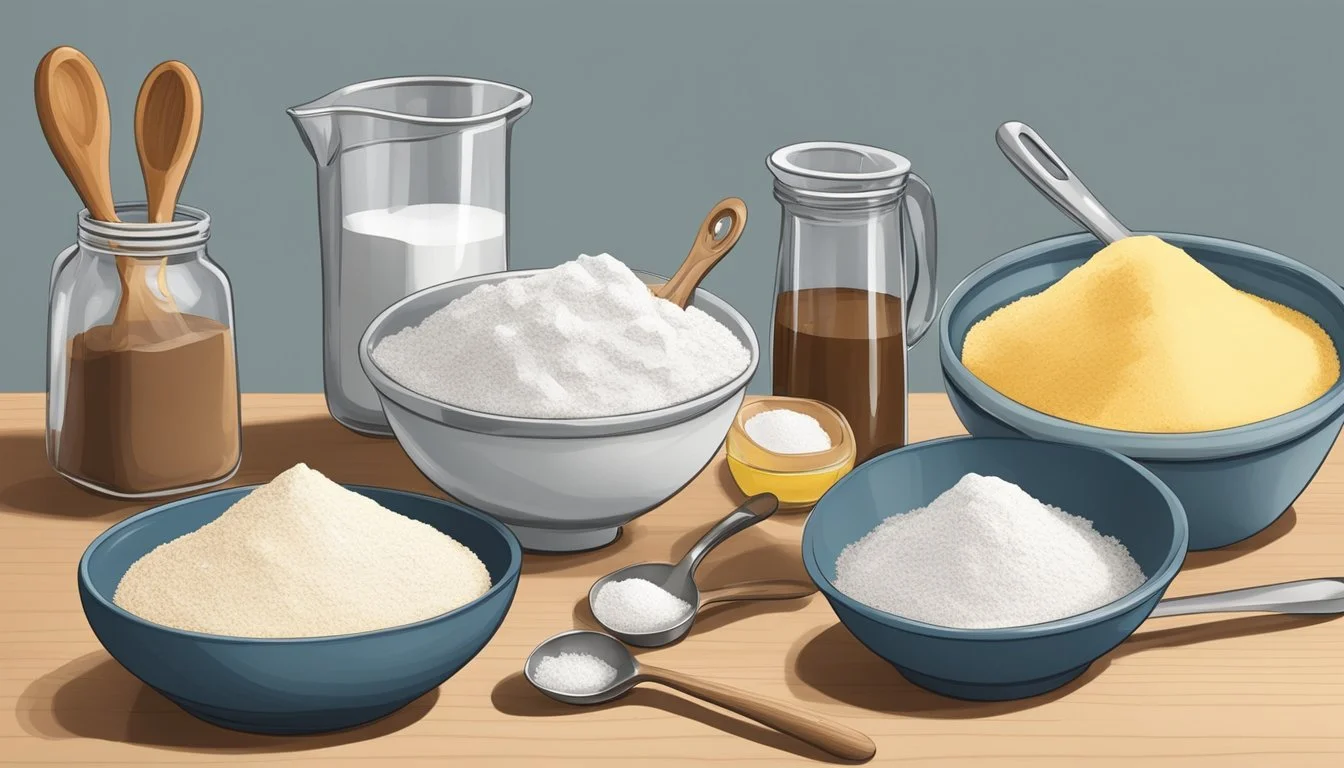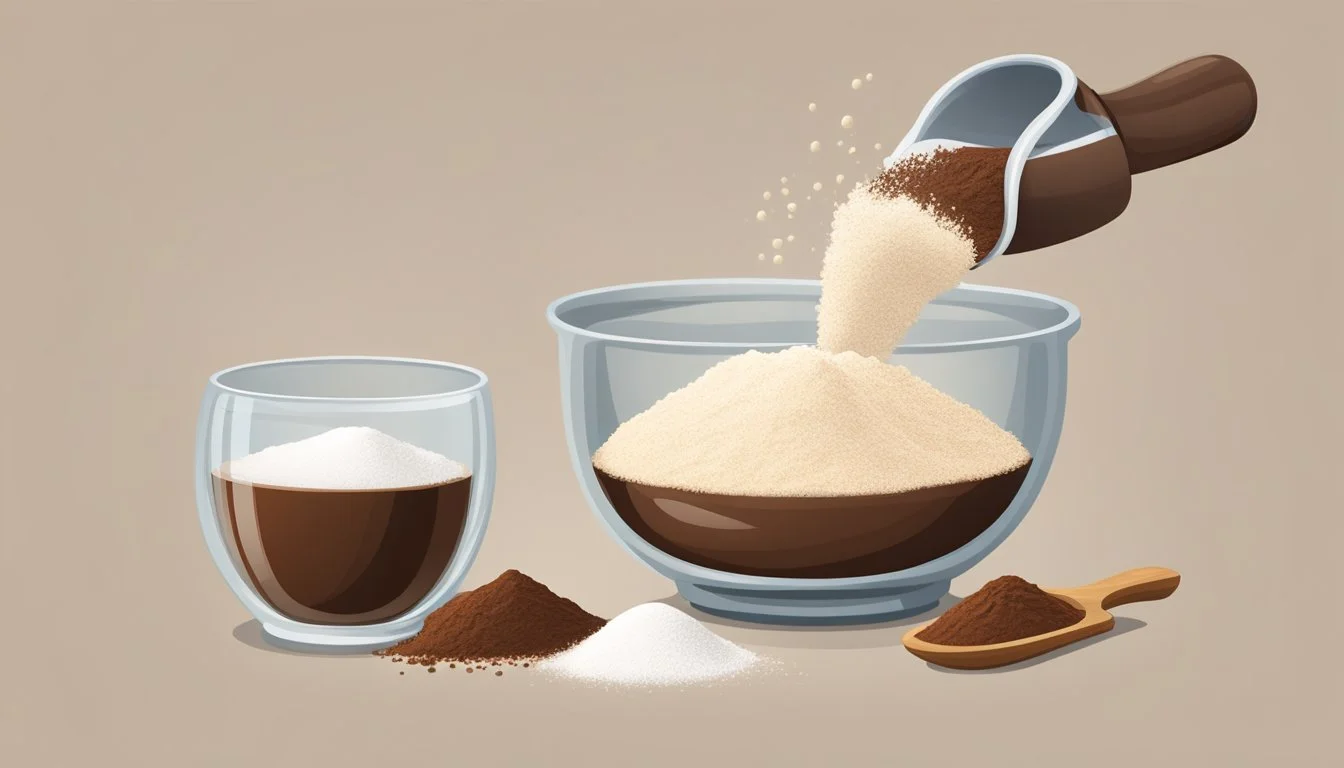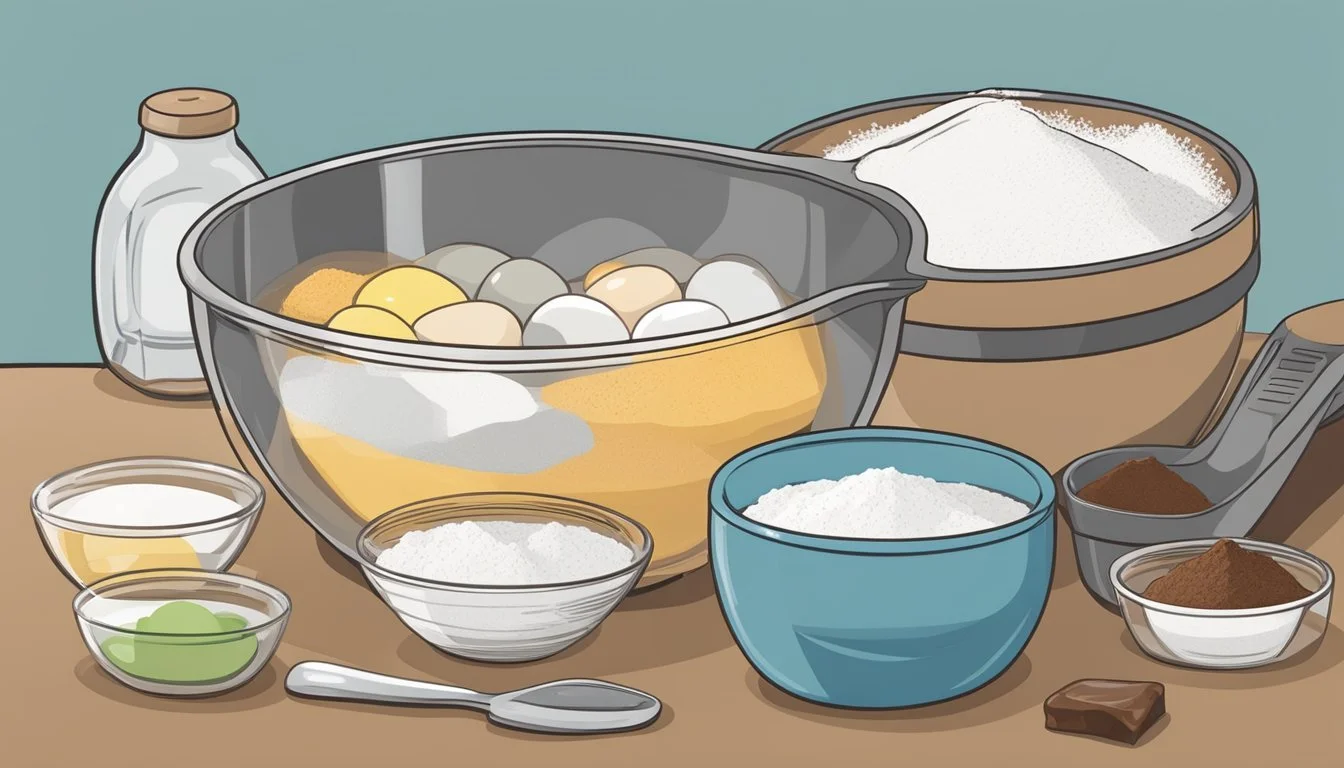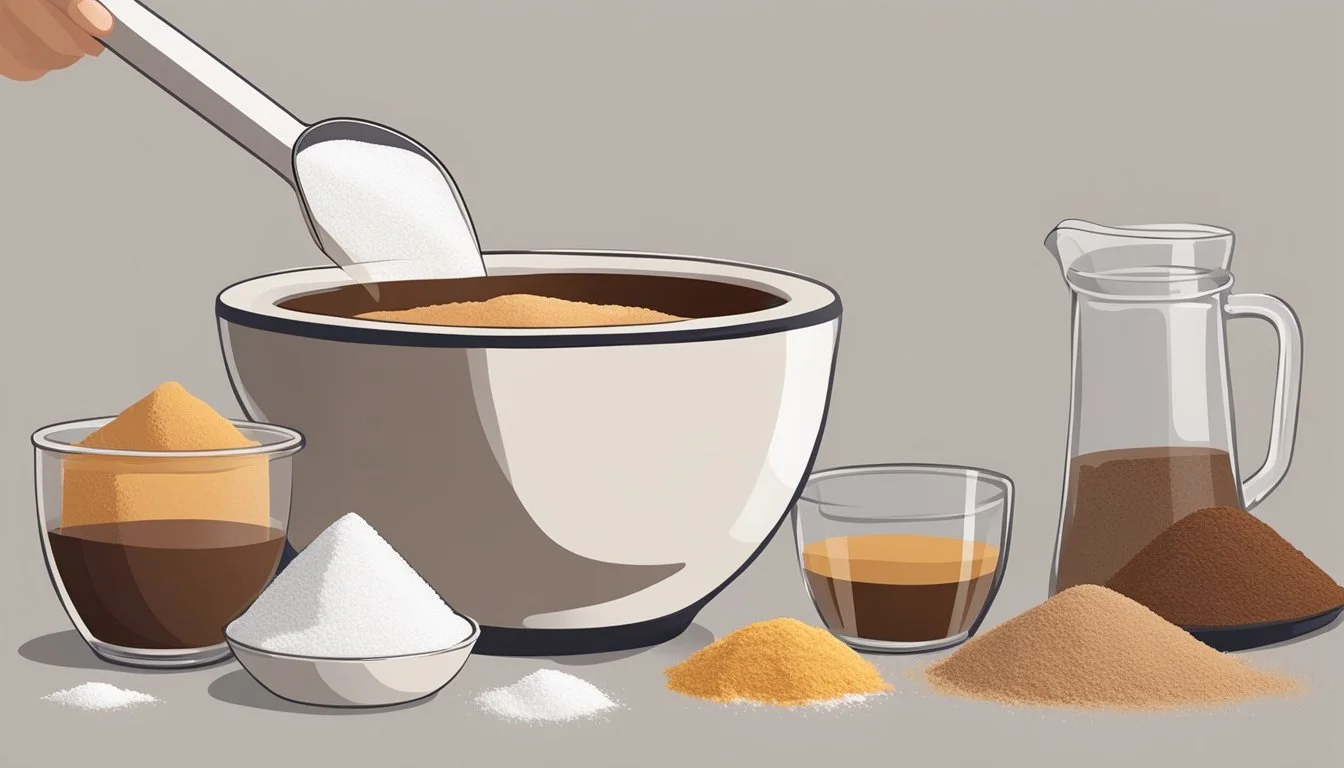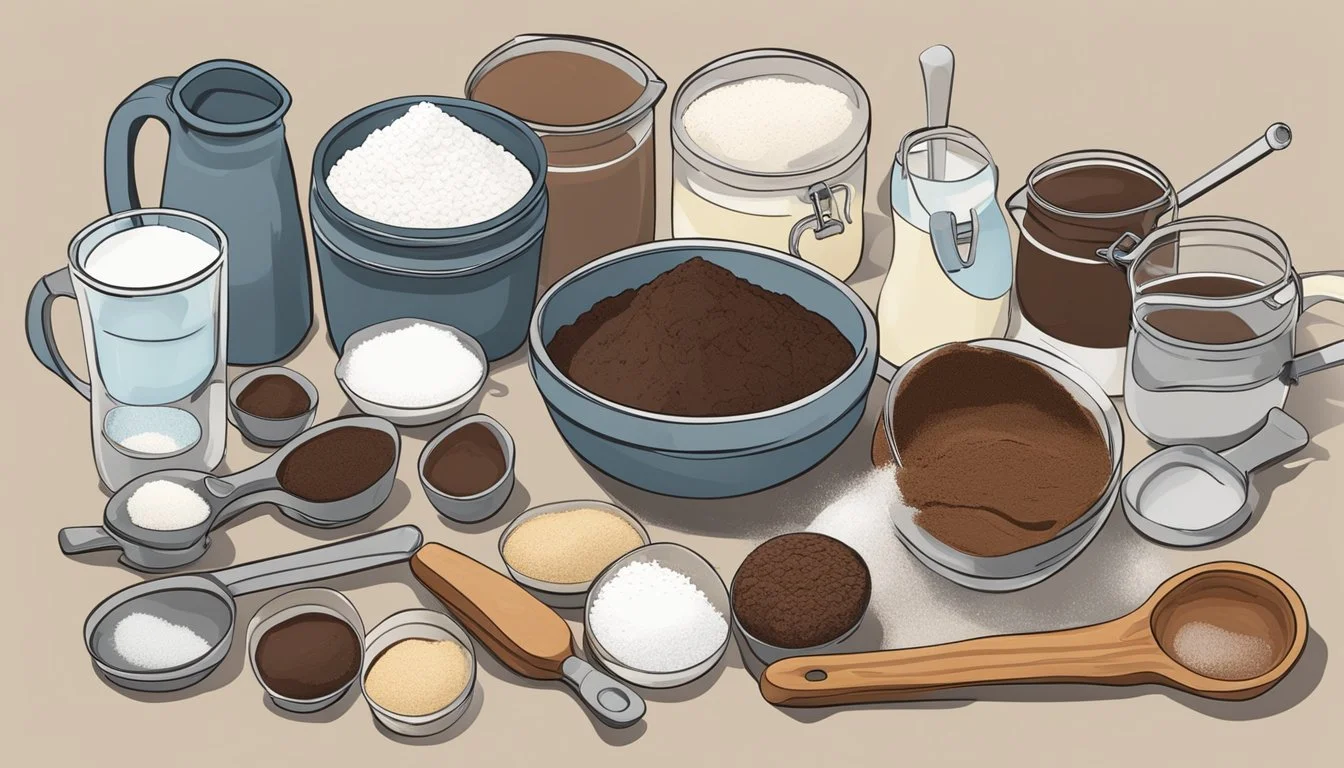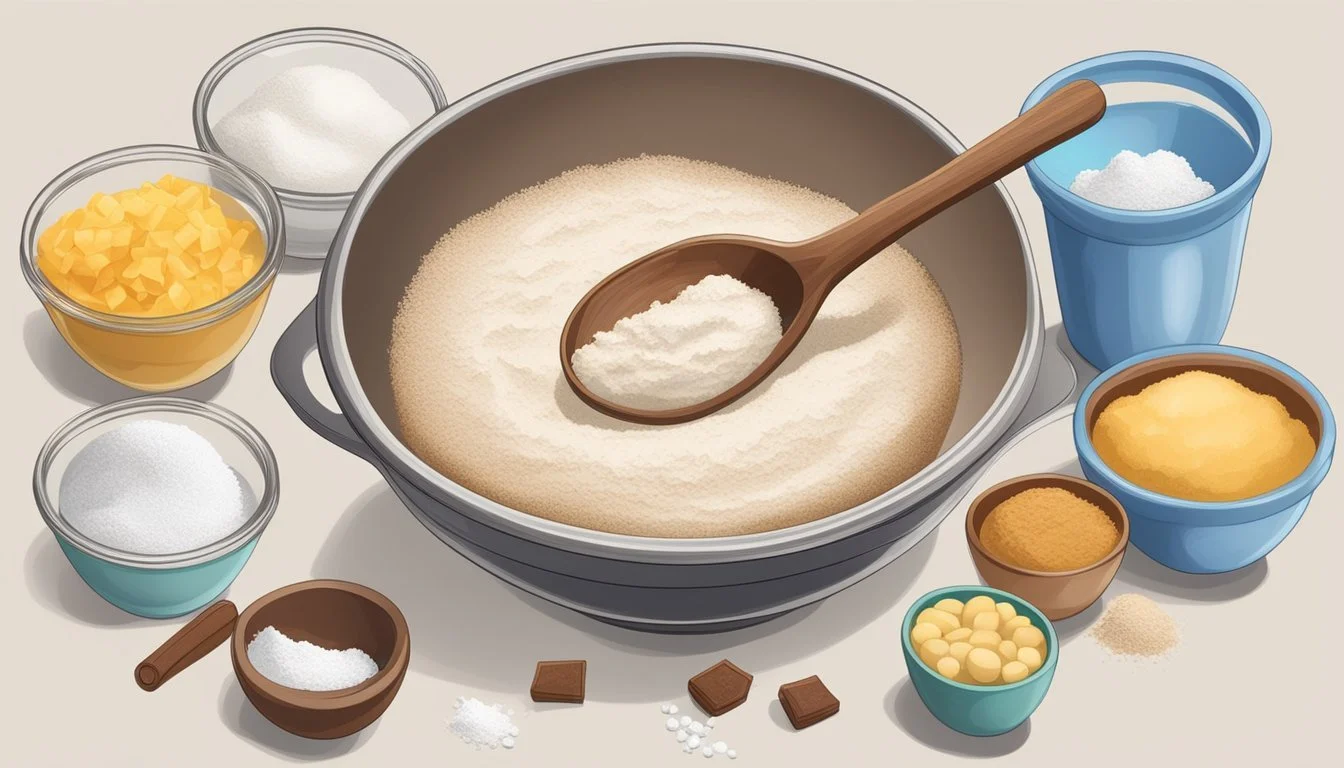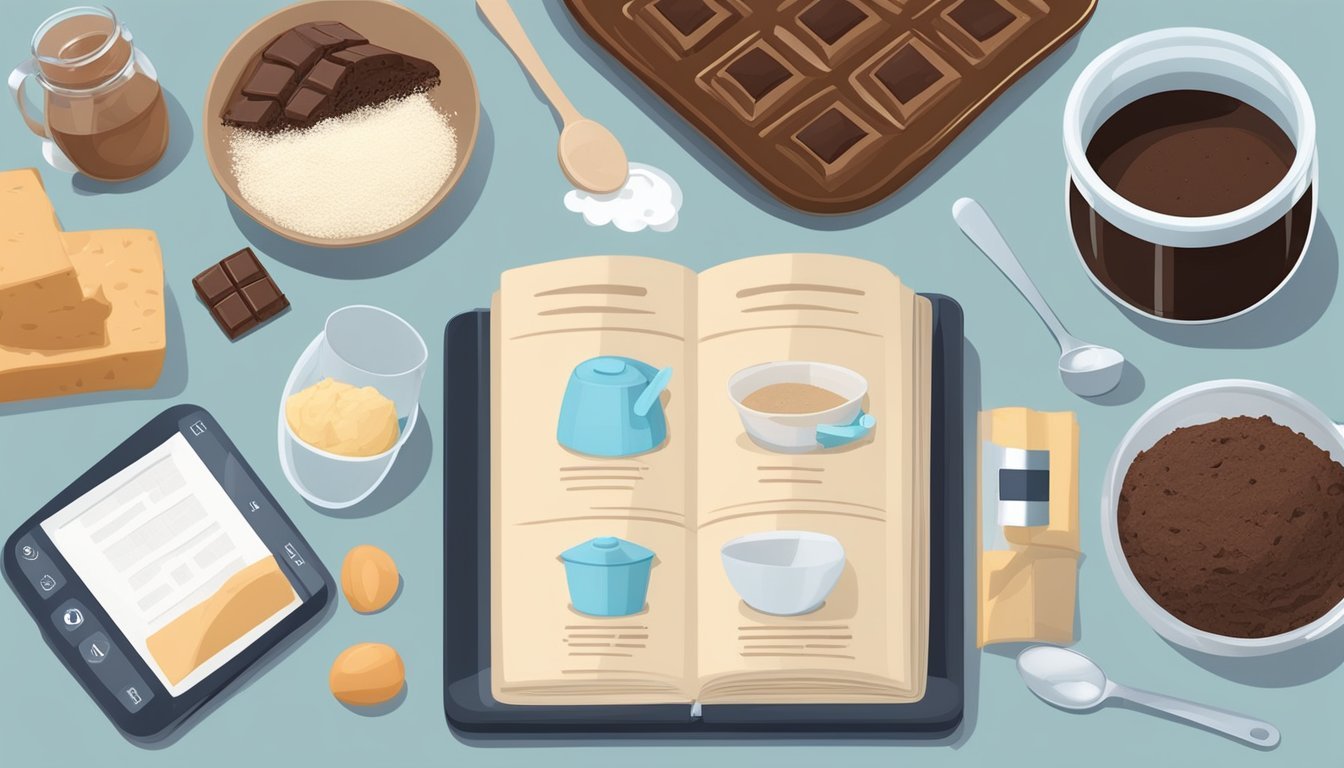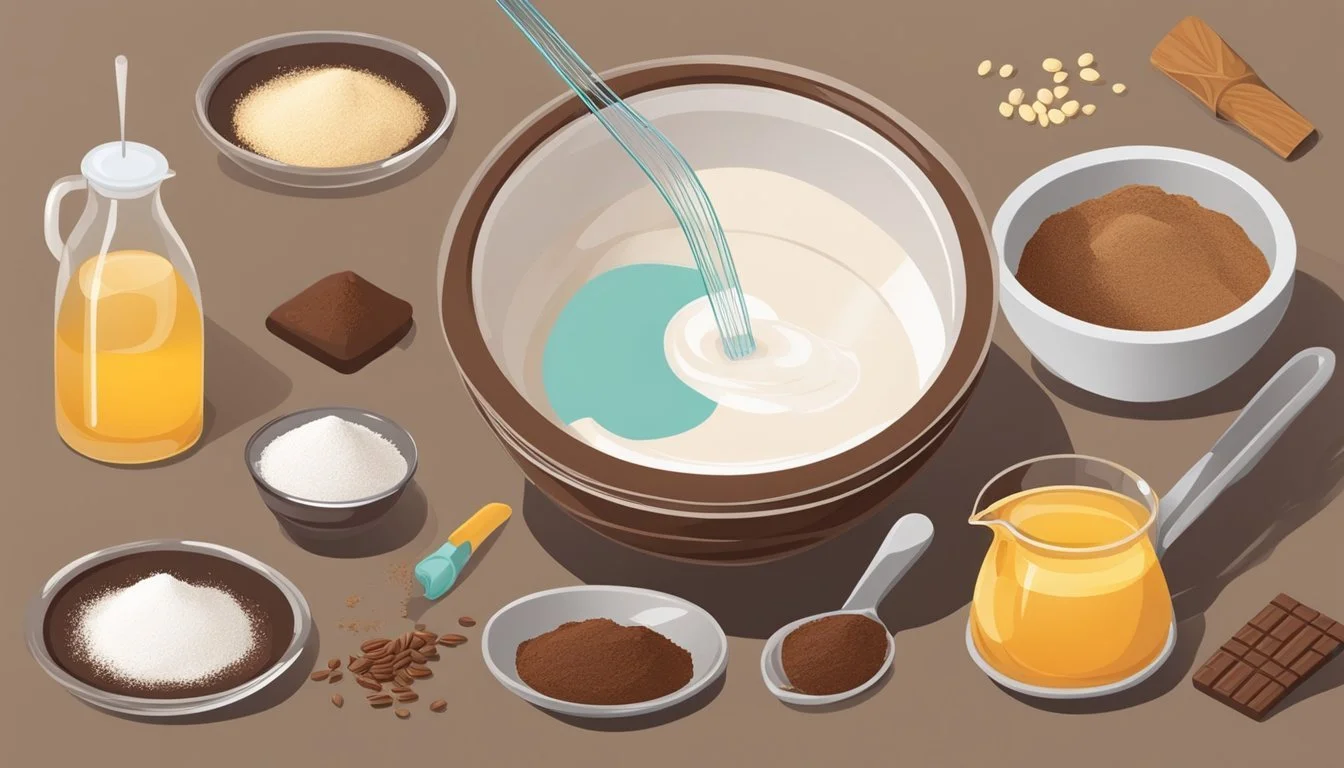How to Measure Ingredients for a Homemade Brownie Mix
Precision for Perfect Results
Measuring ingredients accurately is paramount when creating a homemade brownie mix, ensuring each batch yields a delightful dessert with the perfect texture and flavor. A homemade brownie mix not only offers the convenience of having a ready-to-bake dessert on hand but also allows for customization to personal taste, something store-bought mixes can't fully provide.
When preparing a homemade brownie mix, it's essential to use the correct ratios of dry ingredients like flour, sugar, and cocoa powder. This foundation determines the structure and sweetness of the brownies. Weighing ingredients with a kitchen scale can lead to more consistent results, as it eliminates the variance that can come with volume measurements.
Additionally, incorporating wet ingredients such as eggs, oil or melted butter, and vanilla extract at the time of baking gives the mix its rich and gooey quality brownies are known for. One shouldn't underestimate the importance of adding these components at the right time and in the correct quantities, as they interact with the dry mix to create the final texture that makes brownies a favorite dessert for many.
Understanding Brownie Ingredients
The creation of a perfect homemade brownie mix is dependent on carefully measuring and understanding the role of each ingredient. The correct proportions ensure the ideal texture and flavor.
Flour Dynamics
All-purpose flour is the foundation of brownies, providing structure and stability. The quantity of flour determines whether brownies are fudgy or cake-like; a higher flour content results in a cake-like texture, while less flour leads to fudgier brownies.
The Role of Sugar in Brownies
Sugar does more than sweeten brownies; it also contributes to the moistness and tends to create a shiny, crackly crust. Granulated sugar is typically used, but brown sugar can be added to impart a deeper flavor.
Essential Fats: Butter and Oils
Brownies require fat for a rich taste and a tender texture. Butter adds flavor, while oil makes the brownies softer and more moist because it remains liquid at room temperature. A mix of both can balance flavor and texture.
Eggs: Structure and Consistency
Eggs are pivotal in brownies; they lend stability and richness. The proteins in eggs help to provide the brownies with structure, and the fats contribute to their creamy mouthfeel. Generally, more eggs will result in a cake-like brownie.
Cocoa and Chocolate: Flavor Essentials
Cocoa powder and chocolate (What wine goes well with chocolate?) are the key flavor components in brownies. Unsweetened cocoa powder provides a strong chocolate flavor, while chocolate, whether it be chocolate chips or melted chocolate, adds richness and varying textures.
Leavening Agents: Baking Powder
Baking powder is occasionally used in brownie recipes to lift and lighten the batter slightly, resulting in a softer texture. However, when a dense, fudgy brownie is desired, leavening agents may be omitted to achieve the characteristic dense texture.
Preparing Your Brownie Mix
Creating a homemade brownie mix requires precision in measuring and a methodical approach to combining ingredients. This section outlines the steps to ensure that the dry and wet ingredients are prepared correctly, resulting in the perfect foundation for delicious brownies.
Combining Dry Ingredients
First, one should gather all the dry ingredients of their brownie recipe which typically include flour, sugar, cocoa powder, baking powder, and salt. It's crucial to measure these ingredients accurately, using either a kitchen scale for weight or measuring cups for volume. Here's a quick reference table for common dry ingredients in a brownie mix:
Ingredient Quantity (for 8x8 pan) All-purpose flour 1 cup Granulated sugar 1 to 2 cups Unsweetened cocoa powder 1/2 to 3/4 cup Baking powder 1/2 teaspoon Salt 1/4 teaspoon
Once measured, they should sift these ingredients together into a large bowl to remove any lumps. This can be done using a sifter or a fine mesh strainer. After sifting, using a whisk or a spoon, they need to mix the dry ingredients until they are well combined.
Incorporating Wet Ingredients
Next, the baker should focus on the wet ingredients, which usually include melted butter, eggs, and vanilla extract. The instructions are simple yet important for a smooth brownie batter:
Melt the butter, letting it cool slightly to avoid cooking the eggs when combined.
In a separate bowl, crack the eggs and beat them lightly with a whisk. It's important for the eggs to be at room temperature to ensure even mixing.
Add the vanilla extract to the beaten eggs and mix.
Once these wet ingredients are prepared, they should pour them into the bowl containing the dry mix. They then need to stir the mixture gently but thoroughly until the batter is uniform in texture, ensuring not to overmix as it can affect the brownies' texture.
Brownie Mix Storage Solutions
Proper storage of homemade brownie mix is crucial for maintaining freshness and flavor. The key is to prevent moisture and air from compromising the quality of the mix.
Airtight Solutions
Mason jars are an excellent option for storing brownie mix. They provide a seal that is impermeable to air, which helps in preserving the mix's texture and taste. It's essential to ensure the lid is tightly secured after each use. For those who prefer plastic, Ziploc bags offer a convenient alternative. These bags can be sealed effectively and provide the added benefit of taking up less space.
Examples of airtight containers:
Mason jars with screw-top lids
Ziploc bags
Keeping Ingredients Fresh
To further extend the shelf life of the brownie mix, adding a layer of parchment paper between the mix and the lid can help absorb any excess moisture. This is especially useful in humid climates where moisture can seep in more easily. Additionally, storing the airtight container in a cool, dark place like a pantry or cupboard protects the ingredients from light and heat, which can cause the mix to deteriorate faster.
Tips for freshness:
Place parchment paper under the lid
Store in a cool, dark environment
Brownie Baking Techniques
To ensure homemade brownies are baked to perfection, one must focus on precise oven preparation and maintaining exact baking conditions.
Preheating and Pan Preparation
Before beginning the baking process, it's imperative that the baker preheats the oven to the correct temperature. Most brownie recipes require an oven temperature of 350°F. Consistent heat enables the batter to set properly and cook evenly. Utilize an oven thermometer for accuracy if the oven’s calibration is questionable.
When preparing the baking pan, which is often an 8x8-inch or 9x13-inch size, greasing the pan or lining it with parchment paper prevents sticking and allows for easy brownie removal. A parchment paper sling with overhang on the sides is recommended; it not only assists in clean removal but also aids in effortless cleanup.
Baking Time and Temperature Control
The baking time will vary depending on the recipe and oven, but as a general rule, brownies bake for approximately 25-35 minutes. It is essential to avoid opening the oven frequently, as this leads to inconsistent temperatures that can affect the texture of the brownies. The baker should check for doneness towards the end of the suggested baking time by inserting a toothpick into the center; it should come out with a few moist crumbs, but not wet batter.
Temperature control throughout baking is crucial. If the edges are baking too quickly, the pan can be tented with aluminum foil to protect them while the remainder of the brownie bakes. The precise baking time ensures the desired texture, whether that's fudgy, cakey or chewy. After baking, allowing brownies to cool in the pan for at least 15 minutes helps them set, yet they shouldn't remain in the hot pan too long to avoid overbaking.
Customizing Your Brownie Mix
Creating a homemade brownie mix offers the flexibility to tailor flavors and textures to personal preferences. This section will guide readers through the process of enhancing their brownie mixes with various add-ins and flavor enhancers.
Variety of Add-Ins
In customizing a brownie mix, one can incorporate a variety of add-ins to create a more complex or unique texture. Some popular options include:
Nuts: Walnuts, pecans, or almonds add crunch and a nutty flavor.
Chocolate Chips: Choose from semi-sweet, milk, white, or dark chocolate to increase the chocolatey richness.
Oreos: Crushed Oreo cookies contribute a delicious cookies-and-cream twist.
Peanut Butter Cups: Chopped peanut butter cups introduce a sweet and salty dynamic.
The quantities for these add-ins generally range from 1/2 cup to 1 cup, depending on the desired intensity and balance of flavors.
Flavor Enhancements
The flavor profile of brownies can be elevated by integrating various enhancements directly into the mix. Consider these specific additions:
Vanilla Extract: A teaspoon of vanilla adds depth to the chocolate flavor.
Coffee Powder: A small amount, such as 1/2 teaspoon, can intensify the chocolate taste without adding a coffee flavor.
Salt: A pinch of salt can heighten the overall flavor profile of the brownies.
By carefully selecting add-ins and flavor enhancers, one can transform a basic brownie mix into a customized treat that caters to individual tastes.
Packaging and Gifting Homemade Mix
Packaging a homemade brownie mix tastefully enhances its appeal as a gift. Not only does it add to the visual charm, but it also ensures convenience for the recipient. Thoughtful packaging turns the simple mix into a delightful gift idea.
Decorative Container Options
Mason Jars: A classic choice for both appearance and sealable convenience, mason jars come in various sizes and are easily customizable.
32-ounce jars work well for an average-sized batch of brownie mix.
Embellish with ribbons or fabric on the lid for a personal touch.
Glass Canisters: These offer a sleek look and can be found with airtight seals to keep the brownie mix fresh. A clear canister showcases the layered mix beautifully.
Metal Tins: For a rustic or vintage vibe, select metal tins; ensure they have a tight lid.
Recycled Containers: Environmentally friendly and unique, reused glass bottles or plastic containers can be cleaned and decorated for a personalized gift.
Gift Labels and Instructions
Including preparation instructions ensures the recipient can easily use the brownie mix. Labels can be hand-crafted for a personal feel or printed for a uniform look.
Preparing Labels:
Clearly state the additional wet ingredients needed: typically vegetable oil, eggs, and vanilla extract.
Provide precise baking instructions, such as
Preheat oven to 350°Fand specify the baking time depending on the container size.
Attaching Instructions:
Tie a tag with baking instructions around the neck of a jar or affix a label on the side of the container.
For gift-giving, consider a printable tag that includes a personal message along with the instructions.
The label not only serves as an instruction manual but also as a decorative element that complements the container's aesthetics.
Nutritional Content and Serving Size
When preparing a homemade brownie mix, understanding the nutritional content is important for health-conscious bakers. For a standard brownie mix, the primary ingredients include flour, sugar, cocoa powder, and potentially additional elements such as chocolate chips or nuts, which add to the calorie and fat content.
Calories: A typical brownie serving size, which is usually one square (about 2 inches by 2 inches), may range from 150 to 250 calories, depending on the specific ingredients and their quantities.
Macronutrients:
Fat: 5-15g
Carbohydrates: 20-35g
Protein: 2-3g
The following table provides an estimation of the nutritional content per serving:
Nutrient Amount per serving Calories 150-250 Fat 5-15g Carbohydrates 20-35g Protein 2-3g
Yield: Homemade brownie mix recipes can vary, but a common batch size might fill an 8×8-inch pan and be cut into 16 brownies. Bakers can adjust the size of each serving to meet desired nutritional needs.
For those who prefer more precise nutritional information, calculating the content based on the brands and exact amounts of ingredients used is recommended. This will provide a more accurate account, as different brands can have variable nutritional values. It is also beneficial for those tracking macros or following dietary restrictions to weigh their ingredients for consistency and accuracy.
Further Considerations: Additions such as frosting, cream cheese swirls, or caramel can significantly alter the nutritional content. Keep this in mind when adding toppings or fillings to the basic mix.
Advanced Tips for Perfect Brownies
In crafting the ultimate homemade brownie mix, two critical areas stand out for an experienced baker: attaining the ideal moisture balance and selecting the proper chocolate forms.
Mix Moisture Balance
Moisture is a crucial element in creating the texture of brownies. For brownies with a fudgy interior, one should lean towards a higher fat-to-flour ratio, ensuring that there is enough moisture to yield that characteristically dense and moist texture. It's vital to carefully measure the butter and water content, and if one is using cocoa powder instead of chocolate bars or chips, to adjust the recipe to compensate for the powder's lack of fat.
Key Points for Moisture:
Butter: Melted butter should be used rather than oil for a richer taste.
Water: Minimize or replace water with other liquids such as coffee or milk to enhance flavor and retain moisture.
Eggs: The number of eggs can affect moisture; add an extra yolk for added richness.
Chocolate Selection and Handling
The type of chocolate used profoundly influences the brownie's flavor. Semisweet chocolate is often preferred for a balanced, chocolatey taste, but one can also mix semisweet with unsweetened cocoa powder to control the sweetness and intensify the chocolate flavor. Handling the chocolate correctly is also paramount: it should be melted slowly, either in a bain-marie or microwave at low power, to prevent seizing and to preserve its texture.
Chocolate Guidelines:
Semisweet Chocolate: Use high-quality semisweet chocolate for a pronounced yet balanced chocolate flavor.
Cocoa Powder: Opt for unsweetened cocoa powder to deepen the chocolate presence without adding excess sugar.
Melting Chocolate: Gradually melt chocolate and avoid overheating to maintain its smooth consistency.
By focusing on the balance of moisture and the quality and treatment of chocolate, bakers can elevate their homemade brownies to new levels of perfection.
Comparing Homemade to Store-Bought
When deciding between homemade brownies and store-bought mix, one should consider both taste and quality as well as cost-effectiveness and customization potential.
Taste and Quality Differences
Homemade brownies typically offer a richer flavor and more moist texture when compared with their store-bought counterparts. The freshness of the ingredients in homemade brownies is a principal contributor to this superior taste. In contrast, a store-bought brownie mix might contain preservatives that affect taste and texture.
Homemade Brownies:
Richer, deeper chocolate flavor
Moist and customizable texture
Store-Bought Mix:
More consistent but often less dynamic flavor
Texture can vary, sometimes less moist
Cost-Effectiveness and Customization
Homemade brownie mixes often prove to be more cost-effective, particularly when purchasing ingredients in bulk. They also allow for greater customization; one can add nuts, chocolate chips, or various flavors to suit personal tastes. Store-bought mixes offer convenience but limit personalization.
Cost Comparison:
Homemade: Lower cost over time, especially in bulk
Store-Bought: Fixed cost, potentially higher per batch
Customization Potential:
Homemade: Easily tailored to individual preferences
Store-Bought: Limited options, mostly standard flavors
Moreover, homemade brownie mixes are a chance to make an impression, whether on social media platforms like Instagram, or during a gathering, offering a unique experience not easily replicated by store-bought options.
Troubleshooting Common Brownie Issues
When crafting homemade brownies, precise measurement is crucial for avoiding common issues like problematic textures or problems with rising and cracking. This section will guide you through these common pitfalls to ensure consistent quality in your brownie mix.
Problematic Textures
Dense or Hard Brownies can result when granulated sugar is not measured correctly. Too little sugar may result in a less tender brownie, while too much can make the brownie hard.
Solution: Use a digital scale for accurate measurement. For fudgy brownies, one should aim for a higher fat-to-flour ratio.
Dry or Crumbly Brownies often occur due to overbaking or incorrect proportions of ingredients.
Solution: Stick to the recipe's suggested baking time and check doneness with a toothpick inserted into the center. It should come out with a few moist crumbs attached, not completely clean.
Issues with Rising and Cracking
Sunken Brownies may be the result of underbaking or not enough leavening agent.
Solution: Ensure the oven is preheated to the correct temperature and bake until the edges are set but the center is still slightly soft.
Cracked Tops can be caused by an oven that's too hot or mixing too much air into the batter.
Solution: Use an oven thermometer to verify the accuracy of your oven's temperature and mix just until the ingredients are incorporated.
Alternative Brownie Variations
When baking homemade brownies, incorporating delightful twists like Nutella and peanut butter or merging brownie richness with cookie crunch can elevate the dessert experience. These variations cater to different taste preferences while maintaining the cherished texture and flavor of traditional brownies.
Nutella and Peanut Butter Twists
For those who adore the combination of chocolate and hazelnut, Nutella brownies offer an indulgent twist to the classic brownie. One can swirl Nutella into the batter just before baking, creating a marbled effect. Pairing Nutella with peanut butter brings a balance of nutty and sweet flavors. Peanut butter brownies can be achieved by dropping dollops of peanut butter onto the brownie batter and using a toothpick to create a swirl pattern.
To make Nutella swirls:
Dollop 1/2 cup Nutella on batter, and swirl.
To add peanut butter:
Drop 1/2 cup peanut butter in spoonfuls, swirl with a knife.
Fudge and Cookie Fusion
For a fudge and cookie fusion, also known as brownie cookies or "brookies," prepare a fudgy brownie mix and cookie dough separately. Layer or scoop alternate spoonfuls of the brownie batter and cookie dough into a baking pan. The resulting baked goods have a soft, fudgy center with a crispy cookie crust.
Layering technique:
Spread brownie batter in pan.
Spoon cookie dough on top.
Use a spatula to lightly combine.
These alternative variations provide a rich, complex taste and textural contrast that is sure to be a crowd-pleaser. Whether one prefers the hazelnut touch of Nutella or the classic duo of peanut butter and chocolate, or the indulgent fudgy cookie experience, these twists on traditional brownies create unique and delicious treats.
Equipment Recommendations
When preparing a homemade brownie mix, precision is key for consistent results. The recommended equipment listed below addresses the needs of measuring and mixing ingredients effectively.
Digital Scale: Critical for accuracy, a digital scale ensures that ingredients like flour, cocoa powder, and sugar are measured correctly. This precision impacts the texture and taste of the brownies.
Measuring Cups and Spoons: For home bakers not using a scale, a set of dry measuring cups and spoons is essential. Ingredients should be leveled off for exact measurements.
Mixing Bowls: A set of mixing bowls of various sizes will accommodate both dry and wet ingredients. Glass or metal bowls are preferred as they are durable and easy to clean.
Whisk and Spatula: A whisk helps in thoroughly combining the dry mix. A silicone spatula ensures that wet ingredients blend evenly without overworking the batter.
Baking Pan: An 8×8-inch pan is commonly used for brownies, providing enough depth for batter to rise slightly without affecting the dense texture.
Here's an equipment checklist for convenience:
Equipment Use Digital Scale Measure dry ingredients for accuracy. Measuring Cups Alternative to a scale for measuring ingredients. Measuring Spoons Measure smaller quantities like baking powder and salt. Mixing Bowls Mix dry and wet ingredients separately before combining. Whisk Combine dry ingredients for a homogeneous mix. Spatula Fold wet ingredients into dry mix and scrape the bowl. Baking Pan An 8×8-inch pan is standard for most brownie recipes.
Employing these tools will assist bakers in achieving the perfect homemade brownie mix.
Final Touches: Frosting and Toppings
Properly applied frosting and thoughtfully chosen toppings can elevate a homemade brownie mix to a dessert masterpiece. These final touches add texture and enhance the overall flavor experience.
Frosting Types
Chocolate Frosting: A classic choice, chocolate frosting adds a rich and velvety layer to brownies. For a decadent chocolate frosting, one might incorporate a hint of molasses to deepen the flavor. The frosting should be spread on the brownies once they have cooled completely to prevent it from melting into the surface.
Vanilla Frosting: For those who prefer a lighter contrast to the dense brownie base, a buttery vanilla frosting can provide a delightful counterbalance.
To prepare a simple chocolate frosting, one would typically require:
1/2 cup of softened butter
2/3 cup of cocoa powder
3 cups of powdered sugar
1/3 cup of milk
1 teaspoon of vanilla extract
One would combine the cocoa and softened butter until blended, then alternately add powdered sugar and milk, beating to spreading consistency. Mix in the vanilla last.
Topping Selection
Walnuts: A handful of chopped walnuts add crunch and a nutty essence to brownies, complementing the soft, rich texture of the cake and the smoothness of the frosting.
Additional options for toppings might include:
Sprinkles for a festive look
Sea salt for a sweet and savory twist
Shredded coconut for added flavor dimension
The selection of toppings should harmonize with the flavor of the frosting to enhance the brownies without overwhelming them. Toppings are not just a garnish but an integral part of the final flavor profile. They should be applied after the frosting has been set but before it has hardened completely, ensuring the toppings adhere well.
Inspiring Brownie Ideas from Social Media
Social media platforms, particularly Instagram, are treasure troves for culinary inspiration, and homemade brownie ideas are no exception. They not only offer quick recipes but also encourage bakers to showcase their creativity. Here's a curated list of inspiring brownie ideas discovered on social media.
Creative Toppings and Mix-Ins:
Classic Walnuts: A staple for that perfect crunch.
Salted Caramel: Drizzle or mix in for a sweet and savory twist.
Peppermint Pieces: Great for a festive twist during the holidays.
Instagram-Worthy Presentation:
Layers of ganache and brownie slices create eye-catching patterns.
Dustings of powdered sugar can make for a simple, yet elegant finish.
Bite-Sized Brownie Delights:
Miniature brownies are not only cute but also serve as portion-controlled treats.
Easy Recipe Variations:
Vegan and Gluten-Free options: Substituting ingredients to cater to dietary needs without compromising taste.
Brownie Muffins: Combining the ease of muffins with the rich taste of brownies.
Pre-measured dry mix bins for a quicker preparation time.
Silicon molds for consistent and flawless shapes.
Social media chefs often emphasize the importance of precise measuring for the perfect texture and flavor. Enthusiasts are encouraged to experiment but also reminded to stick to the ratios for key ingredients to maintain the integrity of the brownie's structure. These innovative brownie renditions reflect the current trends that can be attributed to both seasoned bakers and novices sharing their quick and easy recipes online.
How to Make Brownie Mix: Step-by-Step Guide
Creating a homemade brownie mix is a straightforward process that involves measuring and combining dry ingredients. One can store this mix for future use, ensuring they're always ready to whip up a batch of brownies.
Ingredients:
1 cup granulated sugar
1/3 cup unsweetened cocoa powder
1/2 cup all-purpose flour
A pinch of salt
1/4 teaspoon baking powder
Instructions:
Combine Dry Ingredients:
Begin by sifting the flour, cocoa powder, baking powder, and salt into a large bowl to avoid any lumps. This ensures a smooth and consistent mixture.
Add Sugar:
Incorporate the granulated sugar into the sifted ingredients. Stir until the sugar is evenly distributed throughout the mixture.
Mix Thoroughly:
Use a whisk or a fork to blend all the ingredients together thoroughly. The goal is a homogeneous mixture without any streaks or pockets of different ingredients.
Storage:
Transfer the brownie mix to an airtight container, such as a mason jar or a resealable plastic bag. Label the container with the date and the contents.
Important Tips:
When measuring flour, spoon it into the measuring cup and level it with a knife to prevent overpacking.
For best results, all ingredients should be at room temperature.
The mix can be stored in the pantry for up to 3 months or frozen for up to 9 months.
By following these instructions, one will have a homemade brownie mix recipe that is easy to make and ready to be turned into delicious brownies with just a few additional ingredients.
Beyond Brownies: Other Dessert Mixes
Exploring homemade dessert mixes expands a baker's repertoire. One can create easy homemade brownie mix variants or entirely new dessert foundations using similar base ingredients with a few adjustments for texture and flavor.
Cookie Mix
Ingredients contain all-purpose flour, baking powder, and kosher salt for structure and rise, blended with white sugar and brown sugar for sweetness and texture. Add unsalted butter for richness—substitutions with salted butter require adjusting added salt.
Cake Mix
A versatile mix might include all-purpose flour with baking powder as a leavener. Sugar, whether white or brown, adds sweetness, and a fat source like melted butter or vegetable oil contributes to a tender crumb. For the chocolate version, one could use cocoa powder from the brownie mix recipe.
Muffin Mix
Incorporates similar dry ingredients as brownie and cake mixes but often with less sugar and added milk powder. Vegetable oil gives moisture without the need for melted butter, maintaining a lighter texture.
Pancake Mix
Consists mainly of all-purpose flour, a raising agent, sugar, and salt. Instant coffee can be mixed in for a unique mocha flavor, pairing especially well with maple syrup.
Mix Type Unique Ingredient Common Ingredients Cookie - Flour, Sugars, Butter Cake Cocoa Powder (optional) Flour, Sugar, Fat Muffin Milk Powder Flour, Less Sugar, Oil Pancake Instant Coffee Flour, Sugar, Salt
These mixes embody the confident and flexible approach to baking at home. Not only do they make the preparation of desserts more efficient, but they also invite personalization and innovation.
Conclusion
Accurate measurement of ingredients is key to the success of any brownie recipe. For a homemade brownie mix, one must prioritize precision to ensure consistency in flavor and texture. The process begins by sifting dry ingredients such as flour, cocoa powder, and sugar. Sifting not only removes lumps but also aerates the ingredients, which can affect the density of the brownies.
It's imperative to use the correct measuring tools: dry measuring cups for dry ingredients and liquid measuring cups for wet ingredients. When measuring flour or cocoa powder, the scoop-and-level method is preferred. One should spoon the ingredient into the measuring cup and level it off with the back of a knife. For sugar, the ingredient should be spooned in and leveled off as well.
In addition to dry ingredients, wet ingredients like melted butter, oil, or eggs must be measured with care. Melted butter should be cooled slightly before adding to the mix to prevent it from cooking the eggs. Eggs should be at room temperature to incorporate more easily with the dry ingredients.
Bakers should remember the importance of consistency in recipe execution. Each batch of brownie mix should be made with the same meticulous measurement to ensure that the final product is repeatable and of high quality. A baker's precision can transform a simple list of ingredients into an extraordinary dessert that they can take pride in.
By adhering to these guidelines, one ensures that their batch of brownies will turn out delicious and reliable every time. This level of attention to detail elevates a standard homemade brownie mix to one that could rival any professional bakery offering.


